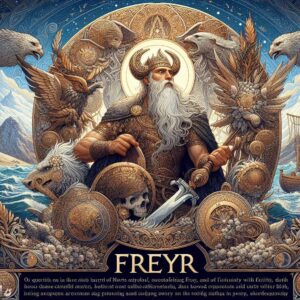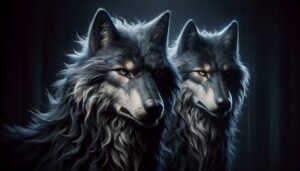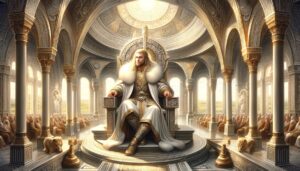Table of Contents
In the rich tapestry of Norse mythology, Freyr emerges as a compelling deity, celebrated for his association with fertility, prosperity, and the sacred bonds of kingship. This article delves into the captivating realm of Freyr, exploring his origins, attributes, and enduring significance in the Norse pantheon.
Origins and Lineage:
Freyr is celebrated as the son of Njord, the sea god. As the twin of Freyja, the goddess of love, he emerges from the Vanir, a principal group in Norse mythology. This ancestry tightly binds him to the sea and nature, embodying the core of fertility. Freyr’s roots intertwine with the essence of abundance, making him a deity intricately connected to the forces shaping world. His divine lineage courses through the realms of sea and Vanir, establishing Freyr as a symbol of life’s flourishing and the eternal dance of renewal in Norse mythology.
Attributes and Symbolism:

Freyr, a deity of resplendent attributes, wields symbols that echo his profound influence in Norse mythology. A radiant figure, he brandishes the enchanted sword, “Sumarbrander” or “The Sword of Summer,” forged by skilled dwarves. This blade, a testament to his power, represents the vitality of the earth and the cyclical rhythms of the seasons.
In addition to his mystical sword, Freyr is accompanied by the divine boar, Gullinbursti, adorned with golden bristles. This boar, symbolizing prosperity and fertility, reinforces Freyr’s association with abundance. Gullinbursti, a creature of divine grace, accentuates Freyr’s role as a harbinger of fruitful harvests and flourishing landscapes.
Freyr and Kingship:
Freyr, revered in Norse mythology, transcends his role as a fertility deity to exert a profound influence on the sacred institution of kingship. Kings of old sought Freyr’s blessings, intertwining their rule with the prosperity of the land.
The association between Freyr and kingship is rooted in the belief that a ruler aligned with this deity ensures well-being. Freyr’s domain extends beyond fields to the success of battles and overall prosperity.
Ancient Norse kings recognized the significance of harmonizing with nature. They performed rituals, seeking Freyr’s favor in dedicated temples. These rituals expressed devotion, weaving the divine into governance.
Freyr’s influence on kingship was not merely symbolic; it was practical and tangible. Kings looked to him for guidance in matters of governance, agriculture, and war. The prosperity of the kingdom was believed to be intricately tied to Freyr’s benevolence, ensuring abundant harvests and victorious campaigns.
During the festival of “Álfablót” or “The Sacrifice to the Elves,” communities gathered in celebration. They offered sacrifices to Freyr to secure his continued favor for the prosperity of their realms.
This communal acknowledgment of Freyr’s role in kingship solidified his status as a patron deity with a direct impact on the fate of kingdoms. In the intricate tapestry of Norse society, Freyr’s influence on kingship stands as a testament to the interconnectedness of the divine and mortal realms.
Kings, as stewards of their lands, looked to Freyr for guidance, acknowledging the deity’s role in shaping the destiny of their realms and the prosperity of their people.
Worship and Festivals:

Active voices echoed through the sacred groves as communities gathered in fervent worship of Freyr, the Norse deity of fertility and prosperity. Temples dedicated to the benevolent god became vibrant centers for communal celebrations and rituals.
During the auspicious festival of “Álfablót” or “The Sacrifice to the Elves,” devotees offered heartfelt sacrifices to Freyr. These rituals, performed with reverence, sought to secure the god’s favor for abundant harvests and overall prosperity. The air resonated with the fervor of communal acknowledgment, each participant actively engaging in the timeless dance between mortals and the divine.
The worship of Freyr was not a passive affair but a dynamic exchange between the people and their deity. Offerings, ranging from grains to livestock, were presented as tangible expressions of gratitude and devotion. The act of giving was an active plea for Freyr’s continued benevolence.
Freyr’s Love Story:
Legacy and Modern Influence:

Freyr’s influence, transcending the epochs of Norse mythology, continues to shape cultural perceptions and inspire contemporary expressions. His enduring legacy, active and vibrant, weaves through the tapestry of both ancient lore and modern interpretations.
In the annals of Norse mythology, Freyr’s legacy endures as a symbol of fertility, prosperity, and the interconnectedness of the divine with the natural world. Kings of old actively sought his blessings, intertwining their reigns with the prosperity symbolized by this benevolent deity.
The echoes of Freyr’s influence resonate in modern pagan practices, where his symbolism is invoked as a source of inspiration. References to Freyr can be found in literature, art, and various forms of creative expression. His imagery, once etched into the fabric of ancient beliefs, now finds new life in the hands of contemporary artists and storytellers.
Freyr’s legacy extends beyond the realms of mythology and pagan traditions. His symbolism occasionally surfaces in popular culture, influencing fantasy literature, films, and other creative works. The enduring appeal of Freyr lies in his dynamic role as a god intimately connected to the cycles of life, a theme that transcends temporal boundaries.
Contemporary adaptations and reinterpretations of Freyr’s stories contribute to the god’s active presence in the cultural landscape. The deity, once worshipped in sacred groves, now finds himself celebrated in virtual realms and artistic expressions, demonstrating the adaptability of ancient myths in the face of evolving beliefs.
As the guardian of fertility and the patron of kingship, Freyr’s legacy remains an active force, influencing both the spiritual and artistic landscapes. His timeless impact on human imagination reflects the enduring allure of gods who, though anchored in ancient myths, continue to shape the narratives of those who actively engage with their stories in the ever-evolving tapestry of human culture.
FAQ
Who is Freyr in Thor?
In Thor, Freyr is portrayed as Freyja's brother, and they share a close bond. The Marvel Cinematic Universe (MCU) interprets and adapts Norse mythology for its storyline.
Is Freyr Freya's son?
No, Freyr and Freyja are siblings, both children of the god Njord.
Are Freyr and Freya related?
Yes, Freyr and Freyja are brother and sister in Norse mythology.
Is Freyr a girl?
No, Freyr is typically depicted as a male god.
Who is Freyr's wife?
reyr's wife is the giantess Gerd, whom he falls in love with.




